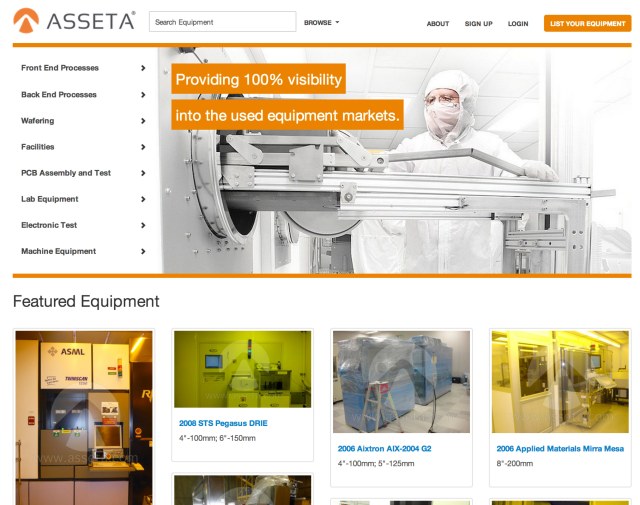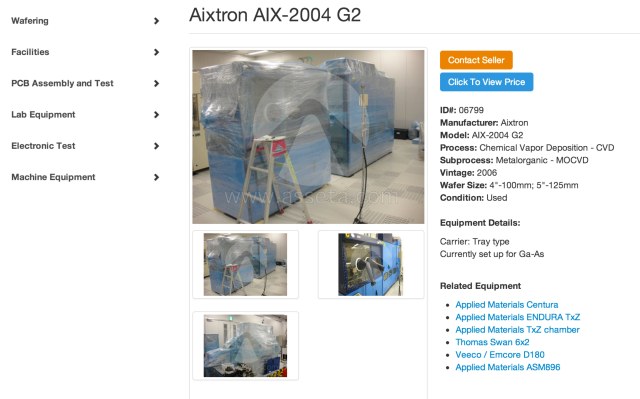Thank you, Y Combinator, for not just investing in a million photo-sharing apps. While you might not be personally excited about an online marketplace where you can buy and sell used manufacturing equipment – and, at launch, primarily semiconductor equipment – a new startup called Asseta demonstrates the potential in taking the now familiar concept of a transparent buyer and seller marketplace to a new vertical, which has yet to be flattened by the power of the web and the one-to-one connectivity it allows.
Like many traditional businesses which have since seen their old ways of doing things transformed in similar ways – anywhere there's a middleman that can be eliminated, that is – Asseta, too, is taking on its own fragmented market of competitors. Today, there are hundreds of used equipment brokers employing sales people who manage the sale of these goods, often without letting buyers know where the equipment comes from, who the sellers are, and definitely not what the real, underlying price of the item is.
Asseta's founders know how this works, of course, because three of the four worked for one of the largest brokers in the business – a company responsible for 1.6 percent of the $6 billion (as of 2010) market in used semiconductor equipment sales.
Explains CEO Anton Brevde, there was no specific event that prompted him and the other founders, including his ex-brokerage co-workers Jonathan Pease and Garrett Beck, or CTO Danial Afzal, to leave their current jobs and build Asseta. "It was just seeing how much money [our former] company was making, and how inefficiently the processes and the company was being run – it just didn't make any sense," says Brevde. "We realized there was a bigger opportunity here…we were all young, and understood the potential of technology. We decided we could do a better job."
The website today is filled with items regular folks won't know much about, but the site is also familiar in a way, with its image-heavy (almost Pinterest-like) look-and-feel, and navigation by category much like you'd find on any marketplace website or e-commerce store.
However, despite the appearance of being simply an "eBay for X," Brevde says that there's much more that needs to be done to make a marketplace like Asseta work for the enterprise. eBay has so far failed to address enterprise needs, in fact, he notes, with its consumer-friendly focus. That's why, in addition to the enabling the communication between buyer and seller, the company is now working to add other components to the site like approvals, contracts, and then finally payments. (Today, it handles these things offline instead.)
To use the site, would-be-equipment buyers can search the now 10,000 live listings from Asseta customers, which includes those from a dozen or some initial partnerships the company formed through their previous industry relationships.
Product info (e.g., make, model, year) is provided on each listing, including, most importantly, price. When a buyer is ready to purchase, they just contact the seller through the system and then Asseta gets involved to help facilitate the sale, and handle the payment, shipment and fulfillment. Commissions are usually 5 to 10 percent, lower than the standard 50 percent on average in the industry. Buyers can also sign up for notifications for equipment they want but Asseta doesn't yet have.
Meanwhile, sellers can upload listings individually or import a spreadsheet. Asseta handles a lot of the grunt work here, including going on site and taking photographs.
Equipment on the site ranges form a few thousand dollars to several million, and, as previously noted, it's mainly semiconductor equipment at present. But the company is now beginning to list other equipment in printed circuit board assembly, optics, LED, and solar, each of which are good-sized markets of their own.
Says Brevde, those other industries will naturally come to the site because of the overlap in technologies, and then Asseta will be able to convert them into uploading the equipment they have for sale, too. Though he declined to provide the number of transactions or exact dollar amount they've processed since launching the online marketplace this June (previously, they had been testing the model offline), he would say that Asseta has already completed "six figures in sales" and is profitable since the marketplace debuted. Outside of YC and YC VC funding, the company was bootstrapped.
As noted above, Y Combinator's backing of Asseta is somewhat unusual – used manufacturing equipment is not normally an industry that the incubator goes after. Brevde admits that they were kind of "an odd one out" during the current YC class. "We've been working on making it easier to understand what we're doing, because in the beginning it was a lot of blank stares," he says.
The team decided to join YC, however, because they had never before done a startup, and Asseta is about making a major transition in an industry from one business model to another. "It felt like we were starting over from scratch," says Brevde. "Being mentored from the people who built Yahoo mail and Gmail really helped."
Y Combinator partner Garry Tan agrees that Asseta is in "an unusual and unsexy space," and it also represents the first time YC has invested in anything of this sort for used equipment.
"But the team is composed of domain experts — guys who know this industry inside and out, and that's why we funded them," says Tan. "Software is eating every market, sexy or unsexy."


No hay comentarios:
Publicar un comentario